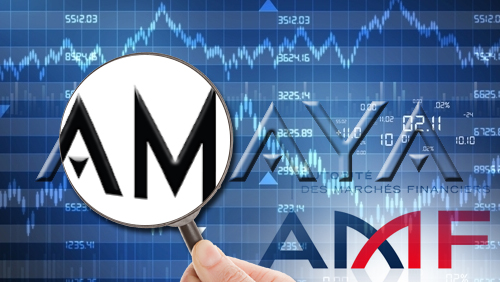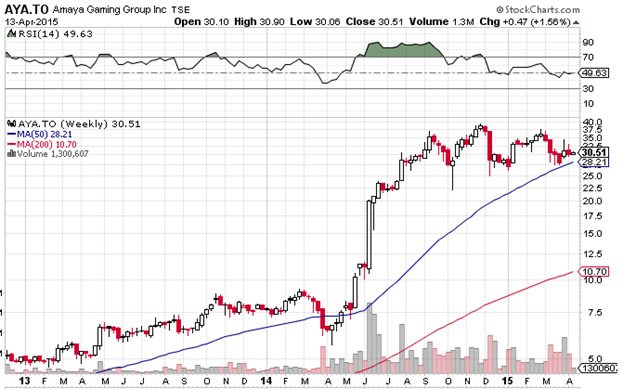 It happens whenever there’s a big market event and securities authorities get bored and want to feel relevant. So they go after high profile people just so they can get their names in the papers as “Administrators of Justice”. Martha Stewart went through it with the SEC, Mark Cuban thankfully escaped it, and now Amaya’s executive inner circle is trying to fend it off as well from the AMF. Insider trading, who knew what when, who traded what in response and why, and how much money did everyone make who might have, Heaven Forefend, known something?
It happens whenever there’s a big market event and securities authorities get bored and want to feel relevant. So they go after high profile people just so they can get their names in the papers as “Administrators of Justice”. Martha Stewart went through it with the SEC, Mark Cuban thankfully escaped it, and now Amaya’s executive inner circle is trying to fend it off as well from the AMF. Insider trading, who knew what when, who traded what in response and why, and how much money did everyone make who might have, Heaven Forefend, known something?
We’ll get into where Amaya is now both regarding this investigation as well as financially and the risks ahead, but first a look at insider trading itself and its supposedly “unfair” and “criminal” nature.
Insider trading laws are like antitrust laws. They’re based on nothing objective, with very loose definitions, and swing based on hunches and the personal feelings of judges and other government officials. How can anyone determine what is insider information and what isn’t? Knowledge is never uniform. Famed investor Jim Rogers, for example, was known and is still known for physically going to places and markets he is interested to invest in, talking to the relevant people, getting a feel for what’s going on. Certainly a lot more than investors do, which is mostly look at computers (like me).
If Jim Rogers has a conversation with a CEO or some big guy in an industry or a government official somewhere who knows something about an imminent war that will rile markets, he has information that I don’t have. And he can act on it. And if he does, other people tend to follow. Is that insider trading or just hard work? Who knows?
It’s the same with antitrust. What’s a trust and what’s not? What’s “cooperation” and what’s “conspiring”? They’re the same thing with different labels, labels applied usually due to public opinion that can swing an election. One is seen as “unfair” while the other is seen as beneficial. But working together is working together. It’s all the same action, for the same purpose of increasing profits to both partners. There is no objective way, try as you might, to separate good old partnering with so called “price fixing”.
But beyond that, if we take a look at what insider trading actually does to the market, we can see on an analytical level that it’s actually a good thing and adds stability to the capital markets. If we look at Amaya’s chart surrounding its acquisition of Poker Stars and Full Tilt Poker, we obviously see a big jump.

Point being, there is a market valuation as defined by a loose trading range before the acquisition, and a new valuation defined by a new trading range afterward. In between there is a time of volatile instability as the new knowledge of Amaya as a new company is being absorbed.
If that knowledge comes out all at once because nobody is allowed to say anything or act on anything until it all comes out in one big flood, The shorter that timeframe of readjustment is, the more volatile the markets, the less people benefit from the change, and the more money those very few who did benefit, make. The less people that know and act on information before it is officially sanctioned as public by some artificial agency, the more volatile the swing will be. As opposed to a hypothetical situation where news leaks out slowly but not through official channels, a select few act upon it and nobody sends them to jail for it, followed slowly by more and more who follow the initial moves without fearing being jailed, until eventually by the time “official” news gets out, many people have already acted on it. The result is a slower, more gradual market revaluation where more and more people have the opportunity to make a profit, though less of a profit than had the revaluation taken place in a day or week.
Insiders can tip off the average retail investor that something big is happening. And that’s a good thing. It allows the retail investor to make a few bucks. And this is what the SEC and AMF consider so evil and illegal and shameful. The government is the one that always says spread the wealth. Well, insider trading does that, gives less and less profit to more and more people. Laws against insider trading prevent it, giving more and more profit to less and less people because nobody is allowed to do anything until everybody knows everything through an officially sanctioned government-approved medium.
The question for Amaya investors going forward regarding the AMF investigation is this: Is this a one-off thing, or is this a sign of government ill-will going forward?
To me it seems like this is an isolated attack that won’t amount to much even in a worst case scenario of full conviction for whatever Amaya is being investigated for. The big danger of course is Amaya’s Canadian revenues. The Canadian regulatory environment being notoriously grey and Amaya being headquartered there, any sudden move by the Canadian legislature to pull an equivalent of the Unlawful Internet Gambling Enforcement Act (UIGEA) that chased 888 out of the US market and gave it a severe beating would be a catastrophe.
This isn’t likely to happen. First, though this is an example of corporatism where Big Business teams up with Big Government, Amaya is now in bed with Loto-Québec, a government gambling agency, in a deal to work with Amaya and block Amaya’s competition. We don’t know the exact details yet, but Amaya, which doesn’t normally come out in favor of government-imposed gaming restrictions, is certainly all for government-imposed gaming restrictions when they restrict its own competitors but not itself. You can’t blame Amaya, even though it’s hypocritical. When the government centralizes and allows fractional reserve lending for example, you can’t blame a bank for loaning out 90% of your demand deposits when all the other banks are doing it, too.
Amaya’s recent divestiture from its Diamond Game lottery division could have been seen as a mistake because it severs the ties it had with the Canadian government through public lotteries and perhaps opens it up to legislative attack, the deal with Loto-Québec dispels that. Amaya will use the proceeds of the upcoming spinoff IPO to pay off debt, (hopefully not buy its own shares), which it really needs to do as soon as possible and as much as possible.
Regarding Amaya’s debt risk, it is substantial. As of its last report, it admitted that a 1-point increase in interest rates would affect its earnings by $17M. Amaya lost $7.5M in 2014, so it cannot afford that on a long term basis. However, there are signs that Amaya is protecting itself of late. Swap agreements were cemented on March 16 which allow Amaya to pay a fixed average rate of 4.6% in synthetic Euro-denominated debt to replace $1.74B in first lien USD debt it took on in August 2014. The agreement goes out 5 years, and it is a very smart move.
Amaya’s debt is still high, but the fact that that they entered this hedge for such a substantial portion of it is a very good sign. Together with the fact that they have $425M in cash and are about to make even more from the Diamond Game spinoff, liquidity looks good medium term.
So in the end, this AMF investigation is a distraction, Amaya’s Canadian market will probably not be suddenly destroyed by the Canadian government considering its deal with Loto-Québec, and Amaya’s debt risk is gradually being lowered. The biggest remaining question is can Amaya lower it fast enough?